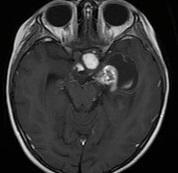Usted está aquí
Peruvian Journal of Neurosurgery
Glioma of the optic pathway and hypothalamus in a child: a case report
JOHN VARGAS U., MANUEL LAZÓN A., RAÚL MARTÍNEZ S., FERNANDO PALACIOS S.
Abstract (Spanish) ||
Full Text ||
PDF (Spanish)
ABSTRACT
Introduction: Gliomas of the optic nerve, visual pathway, and hypothalamus are treated as a single entity, being considered benign neoplasms in pediatric age, grade I according to the WHO. 25% of them are confined to the optic nerve, 40-75% involve the optic chiasm, and 33-60% are posterior lesions. Most do not present symptoms, but in the case of presenting, the most frequent is loss of vision. The gold standard for diagnosis is magnetic resonance imaging (MRI) with contrast. The first line of treatment is chemotherapy, with surgery used for nerve decompression, if necessary.
Clinical case: A 4-year-old woman with a 3-month illness characterized by headache, vomiting, and seizures. The MRI showed a heterogeneous, solid cystic tumor with a solid component that captures contrast. A craniotomy and partial tumor resection were performed, finding both nerves and the optic chiasm thickened. Pathology was reported as pilomyxoid astrocytoma. The patient presented a favorable evolution and was discharged on postoperative day 9.
Conclusion: Gliomas of the optic pathway and hypothalamus are tumors with a benign course in childhood, and their main form of treatment is chemotherapy. Surgery only plays an important role if decompression is required to preserve the patient's visual function.
Keywords: Astrocytoma, Optic Chiasm, Decompression, Craniotomy, Visual Pathways. (source: MeSH NLM)



